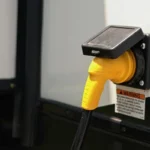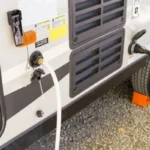Nobody likes a dead battery, especially on the road in your RV. When the temperature drops, one of the most important things to consider is keeping your RV lithium batteries warm. Cold weather can take its toll on them and cause them to become less efficient and even die. Luckily, there are some easy tips of how to keep rv lithium batteries warm and keep it running smoothly in cold weather.
Do Lithium Batteries Need To Be Kept Warm?
The short answer to this question is no; lithium batteries do not usually need to be kept warm. However, it’s important to understand the different types of lithium batteries and how temperature affects each type.
Lithium-ion (Li-ion) and Lithium Iron Phosphate (LFP) batteries are the two main rechargeable lithium batteries widely used in consumer applications such as mobile phones, laptops, and electric vehicles. Li-ion batteries work best at a moderate temperature range between 15°C and 25°C (59°F – 77°F).
Operating them outside this range can decrease performance or cause permanent damage, although their chemical composition doesn’t require external heating. Trying to keep Li-ion cells too warm also carries risks such as thermal runaway, which can cause catastrophic failure if unchecked.
LFP cells have an optimal operating temperature of 0°C – 45°C (32°F – 113°F), which allows them more flexibility when compared with Li-ion cells but still needs to be managed carefully due to their inherent vulnerability outside of this range.
Like with Li-ion cells, too much heat could put LFPs at risk for thermal runaway, leading them into dangerous states where chemicals become highly volatile and potentially explosive under certain conditions.
In most cases, you won’t need a separate heating device or system for your battery pack since modern electronics are designed specifically so that they can maintain normal performance within an acceptable ambient temperature range without additional components or active cooling systems like fans/pumps, etcetera required during operation/charging processes.
Also, bear in mind that it’s often better practice not to operate devices continuously beyond optimum temperatures as doing so increases their susceptibility towards failure, which is why manufacturers explicitly list recommended operating conditions on user information leaflets enclosed inside product packaging prior purchase/use so they should always be consulted when available prior use / disposal, etc.
Also Read: How To Install Rv Electrical Outlet?
How To Keep RV Lithium Batteries Warm | Pro Tips

Use Solar Panels or Wind Generators
Solar panels and wind generators are great ways to provide additional power to your RV lithium batteries during cold weather. They generate energy from the sun or wind, keeping your battery charged and functioning properly in winter.
If you don’t have solar panels or wind generators installed yet, now is a great time to do so! You may also consider investing in an RV solar panel charger for backup power.
Insulate Your Batteries
Another way to keep your RV lithium batteries warm is by insulating them with thermal blankets or bubble wrap. This will help trap heat inside the battery compartment and prevent it from escaping into the air outside.
If you don’t have bubble wrap, you could always use old quilts or towels – ensure they fit snugly around your batteries! Additionally, store your battery inside during extreme cold snaps instead of leaving it exposed outdoors.
Use Battery Heaters
If you’re serious about protecting your lithium battery during cold weather, consider investing in a battery heater kit. These kits have built-in heating elements to keep lithium batteries at optimal temperatures during colder climates.
The heater element maintains a constant temperature in the battery compartment, which prevents it from freezing over – this helps preserve its overall health and extend its lifespan significantly!
Also Read: Does My Rv Have A Built In Surge Protector?
How Cold Is Too Cold For Lithium Batteries?
Lithium-ion batteries are widely used in various applications due to their high energy density, low self-discharge, and long life. However, lithium-ion batteries can be sensitive to extreme temperatures like most battery chemistries. Operating within their optimum temperature window is key to achieving the best performance from lithium-ion batteries.
Generally, temperatures lower than 0 °C (32 °F) can cause irreversible capacity loss and reduce cycle life in many lithium-ion cells. In severe cases, extremely cold temperatures (below -20°C or -4°F) may lead to permanent damage or battery failure.
The good news is that as long as your device operates between 0 and 45°C (32 – 113°F), you should have plenty of margin of safety before experiencing any serious problems with lithium-ion batteries caused by temperature extremes. This should cover most normal application environments where people use their devices daily.
However, there could still be some applications that operate at much higher or lower temperatures outside this optimal range, where you will need to exercise extra caution when designing with li-ion cells.
For those cases, it’s important to understand the expected behaviour of these cells under extreme conditions before embedding them into any system design to avoid unreliable operation from unexpected thermal issues down the line once deployed on-site/in a production environment such:
1. Changes in charging current curves during charge/discharge cycles;
2. Variations in internal resistance over time due to cell aging;
3. Possibility for thermal runaway operating at very high ambient temps (above 45ºC).
4. Permanent capacity decrease if subjected regularly below zero Celsius(0º C).
To sum up, although they don’t love it compared with other chemistries like NiMH or Nickel Cadmium, we must remember Li-Ion Batteries perform better than others closer to room temperature conditions.
So overall, never forget: anything over zero Celsius (~ 32 F) brings out the best results, while storage/operation below this threshold should always be avoided!
Also Read: How To Drain A RV Water Heater?
Bottom Line:
So how to keep RV Lithium Batteries warm. Being proactive when taking care of your RV lithium batteries this winter season pays off! By following these simple tips – using solar panels/wind generators for extra power, insulating them with thermal blankets/bubble wrap, and using a dedicated battery heater kit – you can ensure they stay warm enough to withstand even the harshest of winter temperatures without any issues whatsoever.
Not only that, but these measures will also help extend their overall lifespan, so they last longer than ever before! So what are you waiting for? Get ready for adventures this winter season with confidence knowing that your RV lithium batteries are well cared for!



